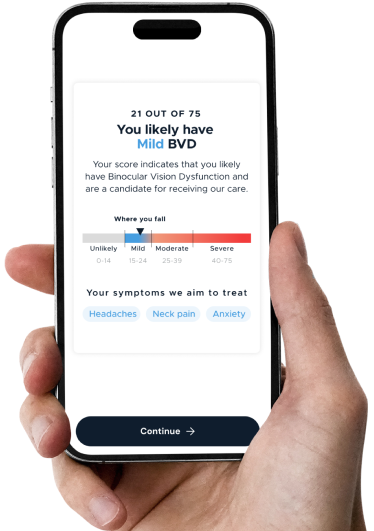Difficulty focusing, restlessness, and reading struggles may not always be ADHD—they could stem from subtle eye misalignment. Binocular Vision Dysfunction (BVD) can mimic ADHD symptoms in children and adults. When standard treatments fall short, a NeuroVisual Evaluation may uncover vision issues as the true cause.
ADHD Symptoms and Treatment: Is It ADHD or Is It Your Eyes?

Written by Mark Rosner, MD
Published: Mar 25, 2025ADHD can significantly disrupt an individual’s quality of life. While this neurodevelopmental disorder is often associated with difficulty focusing, it can cause many other symptoms that can worsen over time when left untreated. Adults can have trouble building relationships and maintaining employment, while children can have difficulty learning. Both adults and children can experience anxiety and other mood disorders, making it even more troubling to find the best approach to treatment.
However, what if the actual cause of your symptoms isn’t ADHD, but a slight misalignment between your eyes known as Binocular Vision Dysfunction (BVD)?
In this article, we’ll discuss the symptoms of ADHD, the treatment available, and how the real issue might be BVD.

What is ADHD?
ADHD, also known as Attention-Deficit/Hyperactivity Disorder, is a chronic condition including attention difficulty, hyperactivity, and impulsiveness. Children and adults who have ADHD have normal intelligence.
There are three types of ADHD:
Inattentive Only: This occurs when the individual has difficulty paying attention.
Hyperactive and Impulsive: This type usually involves the individual having hyperactivity and impulsive behavior. The result is typically disruptive.
Combined Inattentive, Hyperactive, and Impulsive: A person with this type of ADHD will have difficulty focusing and also be hyperactive.
It’s important to note that it’s likely you will experience symptoms similar to ADHD at some point in your life that are temporary. However, individuals are diagnosed with ADHD when the symptoms are severely impacting their quality of life and making it difficult to function.
ADHD Symptoms
The symptoms of ADHD vary from childhood to adulthood and can vary from person to person.
ADHD Symptoms in Adults Often Include:
- Restlessness
- Difficulty planning and completing tasks
- Impulsiveness
- Difficulty prioritizing
- Lack of time management skills
- Mood swings
- Difficulty dealing with stress
- Feeling overwhelmed often
ADHD Symptoms in Children Often Include:
- Distracted easily
- Difficulty following directions (especially at school)
- Trouble completing tasks
- Difficulty focusing on homework assignments
- Unable to stay seated
- Fidgety
- Frequently interrupting
Causes
The medical field has not found an exact cause of ADHD. However, there are several factors that are believed to potentially contribute to ADHD:
Genetics: A person’s genetics is believed to play a role in the development of ADHD.
Environment: Lead exposure could potentially increase the risk in children of developing ADHD.
Developmental Issues: According to the Mayo Clinic, the role of the central nervous system could affect whether or not a person develops ADHD.
Coexisting Conditions
There are several other conditions that can occur alongside ADHD, which can ultimately make the treatment difficult:
Learning Disabilities: Since children with ADHD often have a difficult time concentrating in school and focusing on homework assignments, this can negatively affect their performance in school and development.
Mood Disorders: Depression and bipolar disorder tend to be common in people with ADHD. Anxiety is also common and sometimes the symptoms of ADHD can worsen the symptoms of anxiety (including excessive worrying and feeling overwhelmed).
Psychiatric Disorders: According to the Mayo Clinic, adults with ADHD have a higher risk of developing personality disorders and substance abuse disorders.

What is the Treatment for ADHD?
ADHD symptoms treatment involves several options and oftentimes, multiple treatments are applied at once to help with the symptoms. They include:
Medication
Different medications can help with addressing the symptoms of ADHD. Medication is the most common type of treatment for the disorder, but does tend to bring with it some side effects. These can include difficulty sleeping, loss of appetite, headaches, and upset stomach, among others depending on the specific medication administered.
Therapy
Speaking with a therapist on a regular basis can help individuals with ADHD develop healthy coping mechanisms, improve self-esteem, and improve function overall.
Lifestyle Modifications
Making changes to your lifestyle can help if you suffer from ADHD. Eating fruits and vegetables daily and in general following a healthy diet can make a difference in how you feel. Exercising daily can also help, including walking. Sleep is also important, so make sure you are getting enough sleep every night.
ADHD treatment in adults and children is possible with the right approach.
ADHD in Children
Coping with symptoms as a child might be more difficult than for adults. As a parent there are things you can do to help:
- Increase your child’s self-esteem by giving them tasks that they are capable of completing
- Display calm behavior
- Check-in regularly with your child’s teacher
- Try to maintain a daily schedule for your child that is consistent.
As mentioned above, treatment for ADHD in children often requires a variety of approaches. Diagnosing ADHD in children should only be done by a licensed medical practitioner.
What Does ADHD Look Like In Adults?
Left untreated, adult ADHD symptoms can begin to have a significant negative impact on day-to-day life. Many adults with ADHD experience difficulty focusing at work or in social settings, have trouble managing work assignments, experience severe mood swings, and can often feel overwhelmed. Additionally, some adults will develop depression, drug addiction, anxiety, or experience varying mood disorders.
WIth the right approach to treatment, ADHD symptoms in adults can be managed, enabling individuals to live a full life and help to improve their time management skills.

Could It Be Binocular Vision Dysfunction?
For those who have ADHD, the various treatments mentioned above can often help individuals live full, happy lives. But for many individuals, despite trying a combination of treatments for months or years, they still do not find relief from their symptoms. The issue could actually be a slight misalignment to your eyes, known as Binocular Vision Dysfunction (BVD).
What is Binocular Vision Dysfunction?
Binocular Vision Dysfunction, also known as BVD, occurs when our eyes are slightly misaligned and can lead to symptoms commonly confused with ADHD. While this misalignment between the eyes can be very subtle, it can make it incredibly difficult for our eyes to send one clear image to our brain.
Here’s what happens when someone has BVD: With two eyes, we are able to see one clear image. This is because our brain is easily able to transform the almost identical images seen by each eye into a single image, which is known as binocular vision.
In patients with BVD, there is a slight misalignment between their eyes resulting in their eyes being out of sync with one another. This causes the images seen to be significantly different, making it much more difficult for the brain to process them into a single clear image.
The result? The brain forces the eye aligning muscles to fix the problem by realigning the eyes. But the realignment is only temporary and misalignment then recurs, which is followed closely by realignment, and the cycle of misalignment and realignment continues. Over time, this places an immense amount of strain on the eye muscles and leads to headaches, an inability to focus, and a variety of other symptoms similar to ADHD.
What NeuroVisual Medicine patients say
It Just Makes Me Feel Smarter and Better
Symptoms of BVD
The symptoms of BVD tend to be very similar to the symptoms associated with ADHD.
Common Symptoms for Adults and Children 14+ with Binocular Vision Dysfunction
The following is a list of common symptoms in adults with BVD:
- Difficulty with balance / unsteady walking
- Pain in the neck
- Frequent head tilt
- Motion sickness
- Difficulty reading and learning
Symptoms of BVD in Children Ages 4 to 8-years-old
- Poor handwriting (poor spacing, writing letters too big or small)
- Difficulty reading
- Avoiding activities
- Playing with toys very close to their face
- Sitting close to the TV
- Difficulty identifying shapes, colors, and numbers that are age-appropriate
- Difficulty seeing the class board
- Frequently bumping into objects
- Difficulty catching balls
- Stomach aches and headaches at school or away from home
- Light sensitivity
- Covering one eye to see
- Anxiety in public places
- Frequent squinting in order to see
Symptoms of BVD in Children Ages 9 to 13-years-old
- Repeatedly bumping into things while walking
- Having difficulty completing homework due to headache and nausea
- Repeatedly reading the same things over and over
- Sensitivity to bright lights
- Closing one eye to make it easier to see
- Blurred vision when using the computer
- Blurred vision or tired eyes when looking at the blackboard in class
- Verbal skills that are ahead of reading skills
- Frequent blinking
How Do You Fix BVD?
BVD is treated by correcting the eye misalignment using microprism lenses. These glasses bend light in a way that the images seen by your eyes are moved into the position they need to be in, resulting in realigned images. When the images seen by your two eyes are realigned, your brain can easily transform the almost identical images into one, singular image. Your headaches and other uncomfortable symptoms caused by BVD are significantly reduced or eliminated.
In fact, the average patient will notice a 50% reduction of symptoms by the end of their first visit with a NeuroVisual Medicine specialist. Over the next several visits, the NeuroVisual specialist will fine-tune your lenses so that your headache, nausea, and other BVD symptoms can continue to improve and be eliminated.
Diagnosing BVD
In order to determine if your ADHD symptoms are a result of BVD, it is recommended you visit your primary care physician or a specialist to rule out other causes. If no cause is found for the symptoms, a NeuroVisual specialist can help determine if BVD is the issue.
During your visit:
- We ask you to fill out a specialized questionnaire designed to screen for those who might have BVD.
- You will be asked to complete a detailed Health History form.
- An eye exam is performed to determine the need for correction of nearsightedness, farsightedness, and astigmatism (a common imperfection in the eye’s curvature).
- A specialized exam is performed (NeuroVisual Evaluation) to determine if visual misalignment is present.
- If diagnosed with BVD, you will be fitted with a trial version of their new prescription. Most people notice a significant improvement in their symptoms within just a few minutes of putting on the trial lenses.
You can expect to spend approximately 3 hours in our office during your visit.
Get Treatment for Your ADHD Symptoms
If you or a loved one has been diagnosed with ADHD and is experiencing headaches or other symptoms mentioned above, start with the BVDQ™ Assessment to learn if this is the answer. If BVD is causing the visual symptoms, microprism lenses just might be the solution.

